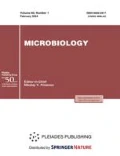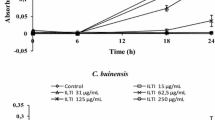Abstract
The mycocin with a molecular mass of at least 15 kDa secreted by Cryptococcus pinus exhibited fungicidal activity at pH values below 6.5. It was thermolabile and resistant to proteases. In the class Tremellomycetes the species of the orders Filobasidiales and Tremellales are sensitive to this mycocin.
Similar content being viewed by others
References
Golubev, W.I., Antagonistic Interactions among Yeasts, in Biodiversity and Ecophysiology of Yeasts, Rosa, C.A. and Peter, G., Eds., Berlin: Springer, 2006, pp. 197–219.
Golubev, W.I, Mycocins (Killer Toxins), in The Yeasts, a Taxonomic Study, Kurtzman, C.P. and Fell, J.W., Eds., Amsterdam: Elsevier, 1998, pp. 55–62.
Golubev, W.I. and Churkina, L.G., Wide Distibution of Killer Strains in the Yeast Rhodotorula mucilaginosa (Jorgensen) Harrison, Izv. AN SSSR, Ser. Biol., no. 6, pp. 854–861.
Golubev, W.I. and Golubeva, E.V., Yeast Fungi of the Steppe and Forest Phytocenoses of the Prioksko-Terrasny Biosphere Reserve, Mikol. Fitopatol., 2004, vol. 38, no. 6, pp. 20–27.
Golubev, W.I and Boekhout, T., Sensitivity to Killer Toxins as a Taxonomic Tool Among Heterobasidiomycetous Yeasts, Studies in Mycology, 1995, no. 38, pp. 47–58.
Buzzini, P., Turchetti, B., and Vaughan-Martini, A.E., The Use of Killer Sensitivity Patterns for Biotyping Yeast Strains: the State of the Art, Potentialities and Limitation, FEMS Yeast Res., 2007, vol. 7, no. 6, pp. 749–760.
Golubev, W.I. and Golubeva, E.V., Mycocinotyping of Filobasidiaceous Species of the Genus Cryptococcus Vuillemin, Mikol. Fitopatol., 2006, vol. 40, no. 6, pp. 480–486.
Golubev, W.I., Pfeiffer, I., and Tomashevskaya, M.A., Cryptococcus pinus sp. nov., an Anamorphic Basidiomycetous Yeast Isolated from Pine Litter, Int. J. Syst. Evol. Microbiol., 2008, vol. 58, no. 8, pp. 1968–1971.
Golubev, W.I. and Kuznetsova, L.B., Formation and Action Spectrum of Mycocins from Basidiomycete Yeast Cryptococcus laurentii (Kufferath) Skinner, Mikrobiologiya, 1989, vol. 58, no. 6, pp. 980–984.
Golubev, W.I., Genus Cryptococcus Vuillemin and Its Type Species Cryptococcus neoformans (Sanfelice) Vuillermin, in Novoe v sistematike i nomenklature gribov (Advances in the Systematics and Nomenclature of Fungi), D’yakov, Yu.T. and Sergeev, Yu.V., Eds., Moscow: Natl. Acad. Mycol., 2003, pp. 357–381.
Gu, F., Khimani, A., Rone, S.G., Flurkey, W.H., Bozarth, R.F., and Smith, T.J., Structure and Function of a Virally Encoded Fungal Toxin from Ustilago Maydis: a Fungal and Mammalian Ca2+ Channel Inhibitor, Structure, 1995, vol. 3, no. 8, pp. 805–814.
Takashima, M., Sugita, T., Shinoda, T., and Nakase, T., Three New Combinations from the Cryptococcus laurentii Complex: Cryptococcus aureus, Cryptococcus carnescens, and Cryptococcus peneaus, Int. J. Syst. Evol. Microbiol., 2003, vol. 53, no. 4, pp. 1187–1194.
Author information
Authors and Affiliations
Corresponding author
Additional information
Original Russian Text © W.I. Golubev, 2009, published in Mikrobiologiya, 2009, Vol. 78, No. 3, pp. 355–361.
Rights and permissions
About this article
Cite this article
Golubev, W.I. Anti-tremellomycetes activity of Cryptococcus pinus mycocin. Microbiology 78, 315–320 (2009). https://doi.org/10.1134/S0026261709030096
Received:
Published:
Issue Date:
DOI: https://doi.org/10.1134/S0026261709030096



